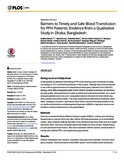| dc.contributor.author | Akhter, Sadika | |
| dc.contributor.author | Anwar, Iqbal | |
| dc.contributor.author | Akter, Rashida | |
| dc.contributor.author | Kumkum, Feroza Akhter | |
| dc.contributor.author | Nisha, Monjura Khatun | |
| dc.contributor.author | Ashraf, Fatema | |
| dc.contributor.author | Islam, Ferdousi | |
| dc.contributor.author | Begum, Nazneen | |
| dc.contributor.author | Chowdhury, Mahbub Elahi | |
| dc.contributor.author | Austin, Anne | |
| dc.contributor.author | Islam, Syed Shariful | |
| dc.contributor.author | Rahman, Aminur | |
| dc.date.accessioned | 2018-01-03T04:45:56Z | |
| dc.date.available | 2018-01-03T04:45:56Z | |
| dc.date.issued | 2016-12-02 | |
| dc.identifier.citation | Akhter S, Anwar I, Akter R, Kumkum FA, Nisha MK, Ashraf F, et al. (2016) Barriers to Timely and Safe Blood Transfusion for PPH Patients: Evidence from a Qualitative Study in Dhaka, Bangladesh. PLoS ONE 11(12): e0167399. https://doi.org/10.1371/journal.pone.0167399 | en_US |
| dc.identifier.other | 19326203 | |
| dc.identifier.uri | http://hdl.handle.net/10361/8881 | |
| dc.description | This article was published in the PLoS ONE [© 2016 PLoS ONE] and the definite version is available at : https://doi.org/10.1371/journal.pone.0167399 . The Journal's website is at: http://journals.plos.org/plosone/article?id=10.1371/journal.pone.0167399 | en_US |
| dc.description.abstract | Background and Objectives
In Bangladesh, postpartum hemorrhage (PPH) is the leading cause of maternal mortality accounting for 31% of all blood transfusions in the country. Although safe blood transfusion is one of the 8 signal functions of Comprehensive Emergency Obstetric Care (CEmOC) strategy, most of the designated public sector CEmOC facilities do not have on-site blood storage system. Emergent blood is mainly available from external blood banks. As a result, emergent patients are to rely on an unregulated network of brokers for blood which may raise question about blood safety. This study explored lived experiences of patients’ attendants, managers, providers, and blood brokers before and after the implementation of an on-line Blood Information and Management Application (BIMA) in regards to barriers and facilitators of blood transfusion for emergent patients.
Methods
Data were collected at Dhaka Medical College Hospital (DMCH), a tertiary-level teaching hospital before (January 2014) and after (March 2015) the introduction of an online BIMA system. Data collection methods included 24 key informant interviews (KIIs) and 40 in-depth interviews (IDIs). KIIs were conducted with formal health service providers, health managers and unlicensed blood brokers. IDIs were conducted with the relatives and husbands of women who suffered PPH, and needed emergency blood.
Results
Patients’ attendants were unaware of patients’ blood type and availability of blood in emergency situation. Newly introduced online BIMA system could facilitate blood transfusion process for poor patients at lower cost and during any time of day and night. However, service providers and service recipients were heavily dependent on a network of unlicensed blood brokers for required blood for emergent PPH patients. Blood collected through unlicensed blood brokers is un-screened, unregulated and probably unsafe. Blood brokers feel that they are providing a needed service, acknowledged a financial incentive and unaware about safety of blood that they supply.
Conclusions
Ensuring safe and timely blood transfusion is necessary to end preventable maternal mortality. In a context where facilities have no on-site blood, and both providers and patient attendants are heavily dependent on an unregulated cadre of unlicensed blood brokers, access to timely safe blood transfusion is seriously threatened. BIMA is a promising intervention to reduce inefficiencies in obtaining blood, but steps must be taken to ensure buy-in from current purveyors of blood, and to increase the acceptance of the intervention. | en_US |
| dc.language.iso | en | en_US |
| dc.publisher | BRAC Univeristy | en_US |
| dc.relation.uri | http://journals.plos.org/plosone/article?id=10.1371/journal.pone.0167399 | |
| dc.subject | Blood transfusion | en_US |
| dc.subject | PPH patients | en_US |
| dc.subject | Health Bangladesh | en_US |
| dc.title | Barriers to timely and safe blood transfusion for PPH patients: evidence from a qualitative study in Dhaka, Bangladesh | en_US |
| dc.type | Article | en_US |
| dc.description.version | Published | |
| dc.identifier.doi | https://doi.org/10.1371/journal.pone.0167399 | |

